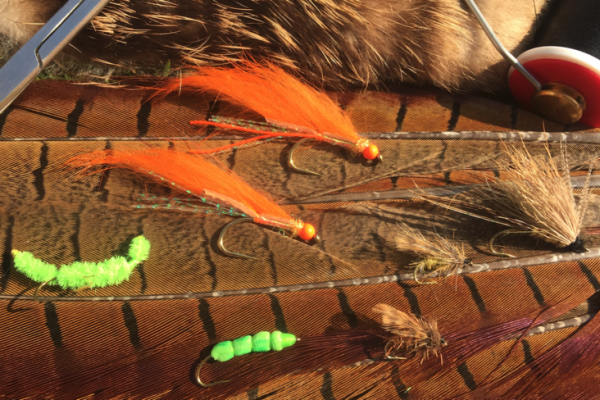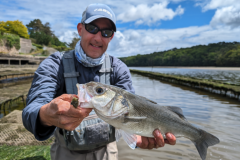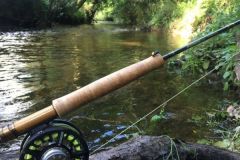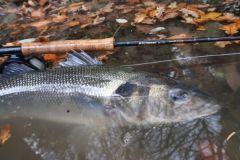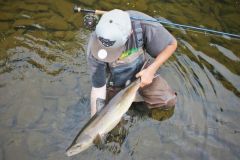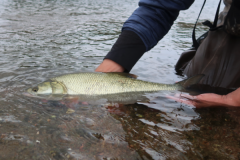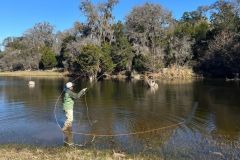1-Emergent mayfly
The May fly is one of the most eagerly awaited outbreaks on French rivers populated by this mayfly ( ephemera danica and vulgata ). They are often massive, as in Normandy, but also in Brittany, and trigger an activity not to be missed.
On some rivers, this is the most important hatch of the year, and one during which it's possible to outwit large fish who take advantage of the opportunity to gorge themselves and put on weight.
Emergence is a key phase for this fly. The insect is vulnerable. You absolutely must have this pattern in your box to complement the high floating patterns that trout take but often at a well-defined moment in the hatching phase of this magnificent fly with its elegant and majestic flight. The spent is not to be forgotten either.
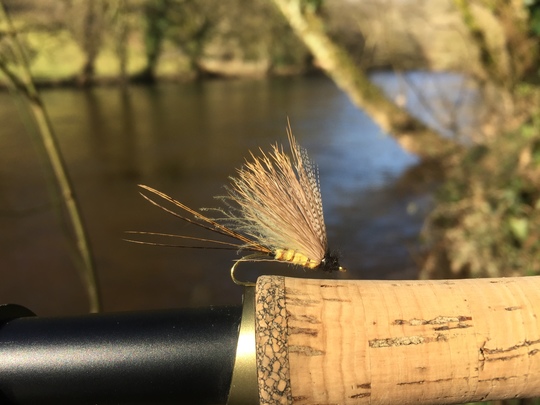
Assembly sheet
Tiemco 200R hook in size 10 or 12
UTC 70 black mounting wire or equivalent
Attach a few pheasant tail fibers (4/5) by passing the mounting thread 2/3 times behind them âeuros possibility of mounting a few pardo fibers on top (but float higher)
Secure a few pheasant herls (2 or 3) by the end of the thick brown mounting wire.
Then attach to the bend and wrap with yellow wool or pale yellow Uni Yarn or equivalent. Form a conical, slightly chunky body. Then hoop well-spaced with pheasant or brown yarn.
Attach a few fibers of CDC gray or pale yellow or a mixed underwrap.
Secure a good tuft of venison over it, keeping all the hairs on top of the hook and holding it to the top of the shank while securing.
Attach a few fibers of natural or yellow male duck breast.
Make a (good-sized) black head out of black hare or squirrel dubbing to imitate head and legs.
Finishing knot.
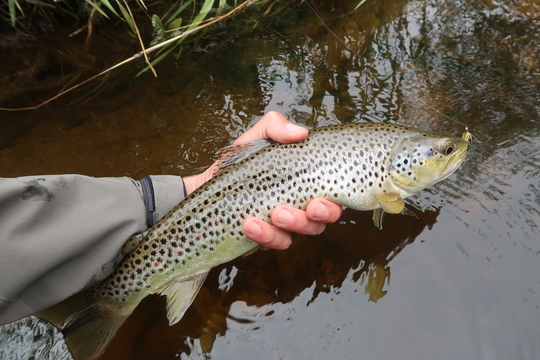
Tips and tricks
I tie this fly in two sizes, but I prefer size 12 to have a smaller fly and then go down to size 14 for more discretion, unless big fish are present. It turns out that trout also take smaller models well.
This fly has a low floatation and imitates very well the sub-imago which is very often the most vulnerable stage and the one trout are looking for.
By greasing the fly a little and shaking the rod tip (halfway up), you can make the fly hop or slide over the surface, imitating an insect struggling and trying to fly away. Sometimes this animation triggers some overfished or undecided fish.
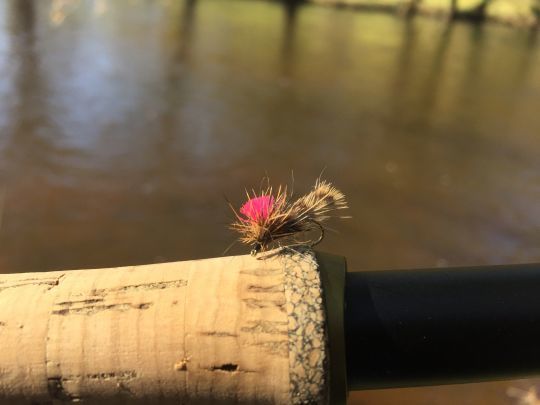
2-Sedge en cul de bécasse
Trichoptera are undoubtedly the most common aquatic insects found in our waterways, as they can withstand certain types of pollution and adapt to a wide range of environments.
By varying sizes and body colors (red, olive, green, black, etc.), this fly can represent a multitude of sedge families.
Woodcock feathers, so hard to come by, are perfectly suited to tying this fly with their natural russet/light brown and mottled colors.
A fly to have in your boxes all year round for evening strikes, but not only. In small sizes (16 and 18), it's a catchy all-rounder.
Assembly sheet
Tiemco 100 hook in size 18/16/14/12
UTC 70 black mounting silk or equivalent
Come to the bend and put on a hare or squirrel dubbing of the desired color. Wrap the dubbing in a conical shape without providing too much so that it is airy and gives good flotation. Stop at 2/3 of the shaft.
Take two identical woodcock butt feathers and attach them one by one in the shape of a roof.
Prepare a dubbing loop and trap a 1cm tuft of hare's hair. This can be from the ear for a short hackle imitating a sub-sedge, or from the hare's back (longer) to replace a hackle. Curl the hare and pull back all the hairs on one side, then roll it up in 2 or 3 turns. You can provide more or less to obtain different floats.
Make a head of black mounting silk, then tie a finishing knot. Varnish or not.
Tips and tricks
This model is extremely effective and formidable. It can be mounted in a wide range of sizes and colors to suit the hatching season.
The hare allows it to float at different heights. Depending on the density of hairs used, it will float lower or higher on the water. The hare bristles can be pulled off to suit the conditions, and the fly can be either in the film or just below it. In short, a trout magnet. It's also a good idea to use a deer-ear hackle, which floats a little higher, or a red hackle (which doesn't allow you to adjust the floating height).
The hackle can be mounted as a parachute hare to float even more differently, and a very colorful tuft to increase its visibility in currents.
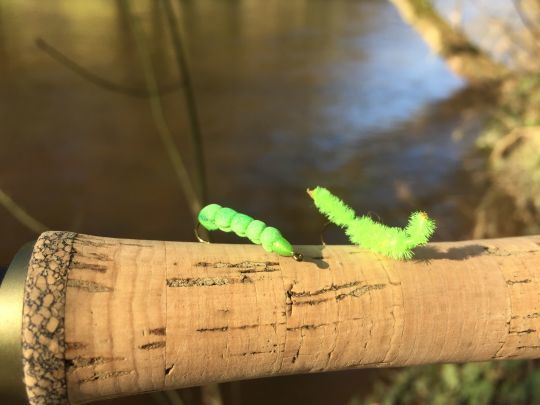
3-Chenille
Many species of caterpillars live together in the riparian zones of our waterways. On oak and willow trees, beautiful green caterpillars drive trout crazy between April and May.
They descend from the trees by a small silken thread, or sometimes fall suddenly into the water.
The trout are waiting for them and gobble them up furiously under the foliage. You might think that the trout are after other insects, but it's the caterpillars that attract all the attention!
Other grayish, brownish or blackish caterpillars (alder) also fall into the water depending on the season, and it's essential to have them in your boxes all year round.
Installation sheets
I've come up with two layouts, but feel free to innovate or try out other designs to suit your taste.
Slow immersion caterpillar that flows smoothly like a real caterpillar, very simple:
Tiemco 200 R hook in sizes 10 and 12 or Daichi 1770 in the same size (wave-shaped).
Chartreux or green/yellow mounting silk.
Attach a piece of green-chartreuse microchenille to the bend, leaving a piece of about 0.5 mn to 1 cm long. Burn the end with a lighter.
Make an underbody of chartreuse green silk and keep the thread at the head. Wrap the caterpillar around the shank, returning to the eyelet.
Let the micro-chenille protrude for 1 cm and burn the end.
Finishing knot.
Floating foam caterpillar / foam :
Tiemco 200 R hook.
Chartreux or green/yellow mounting silk.
Attach a green/chartreuse strip of foam 3 or 4 mm wide and slightly longer than the shank of the hook through the middle (halfway down the strip and in the middle), so that you have a strip of foam above and below the shank.
Fold the strip over on both sides and lock it in place to form a first ball, then repeat the operation 3 or 4 times up to the eyelet, to imitate the caterpillar's annulations. Finish with a green head of mounting silk (or black), then add a little UV glue.
Tips and tricks
Personally, I use both set-ups, but very often the sinking caterpillar, because in the end, once on the water, the caterpillar sinks slowly and naturally.
In this case, I mount the caterpillar under a gallows dry fly (about 30 cm) or by attaching it to the hook (if barbed). I often use it under a sedge or a mayfly, depending on whether the fallout is in April (sedge) or May (mayfly).
The touch is felt when the dryer stops or sinks, or if an eddy forms behind your dryer. Close immediately!
Sometimes when gobbling, I throw the floating model directly at the fish, slamming it down a little to reproduce the fall of the caterpillar. The gobbles are very fast and noisy and cause a lot of misses. With the sinking model, trout are caught almost 100% of the time! The other advantage of the two-fly rig is that the dry fly can also be gobbled up.
NB: An imitation Ryacophila nymph (bottle-green/chartreuse with a black head) can also be very attractive at this time of year.
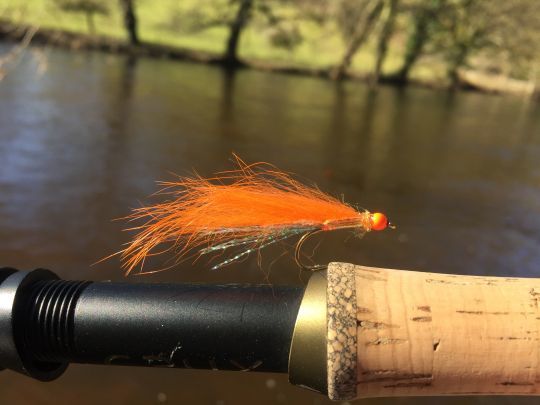
4-Shad fly
The shad season runs from April to early June. The first shad enter freshwater when water temperature exceeds 12°C.
The first ones arrive in April, but it's mainly in May that they'll be present in sufficient numbers to be caught regularly.
This fly has been effective for me on every corner where I've been able to look for shad, varying in size, weight and color.
Assembly sheet
Kamasan hooks B175, B170 or streamer in size 4/6/8.
To be mounted in orange, chartreuse and pink, my favorite colors.
UTC 70 fluorescent orange mounting silk or equivalent
Position a 3.3 or 3.8 orange (or other color of choice) brass ball.
Start by attaching a few kristal flash fibers to the tail, either pearl or the overall color of the fly.
Then attach the (thin) rabbit band to the bend, leaving about 1 to 2 cm protruding. Not too long to avoid short strokes.
Form a mounting silk underbody and cover with kristal flash, flashabou or lateral scale pearl. The mounting silk shows through under the flash.
Fix the rabbit band behind the bead. Add a kristal flash fiber on each side.
Apply a little fluorescent orange Hends dubbing (or other color depending on your choice of fly color). Then tie a finishing knot.

Tips and tricks
Fits size 4/6/8 or even 10. My favorite colors are fluorescent orange, chartreuse, pink (and yellow).
It can be weighted with a lead sub-body, or a tungsten ball can be used instead of brass if you need to descend quickly (current or deep station).
I sometimes add plastic legs to the tail, in the same color as the fly, to increase vibration.
In fishing, the fly is really effective, but it is of course essential to fish :
1- at the right depth
2- at the right speed
3- vary the size throughout the season (smaller and smaller)
This fly should be used as an inert drift, especially for large shad, but sometimes with a few pulls or strips, and very often in short, fast strips for feinting shad, which react very well to lively, jerky animations.
A fly that also works for sight fishing when possible.
